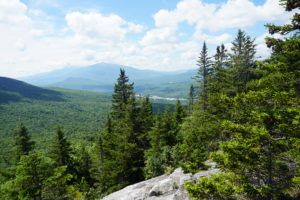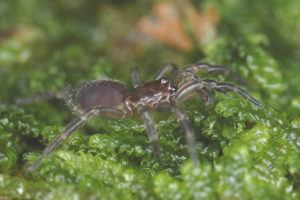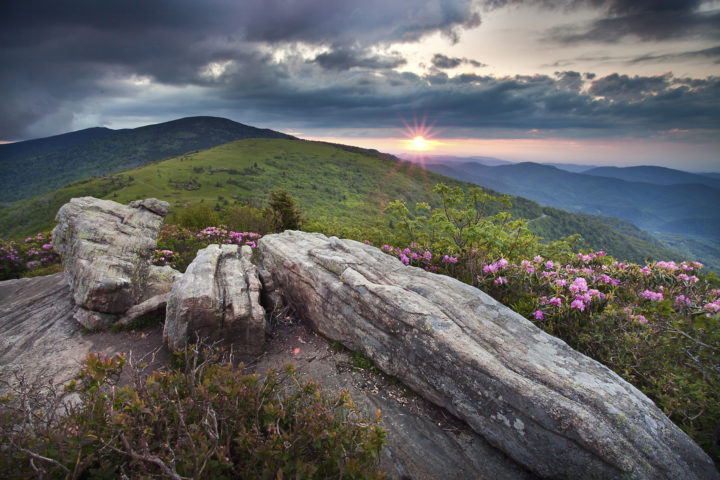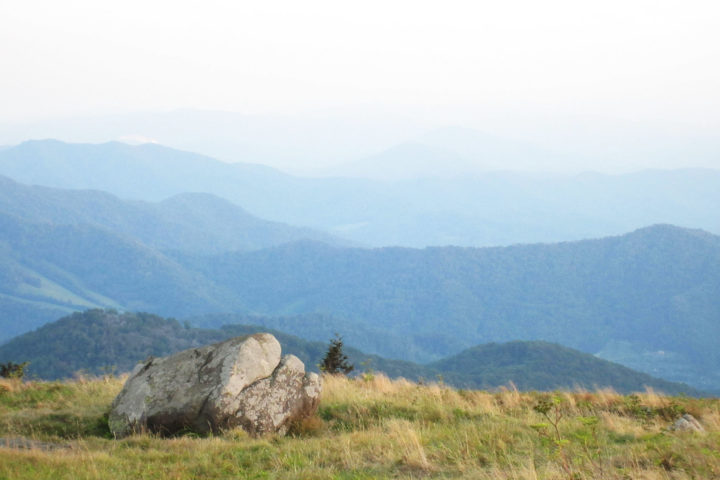By Dan Hale, ATC New England Natural Resource and Land Stewardship Manager
Montane Spruce-Fir Forests
August 11, 2020
One of my favorite things about climbing mountains on the Appalachian Trail (A.T.) is observing the forest transition from spacious broadleaf trees into evergreen trees that grow tighter and shorter as the elevation rises. Lichens hang from trees, mosses carpet the ground and the Trail gets rockier as the soil gets thinner. In the cold, harsh and cloudy climate of tall mountains and northern latitudes, you’re likely to find a Montane Spruce-Fir Forest.
Montane Spruce-Fir Forests can be found in the upper elevations of the Appalachians, like Mount Greylock and Mount Moosilauke, and as far south as the North Carolina-Tennessee border in areas like Roan Mountain and Mount Rogers. That far south, spruce and fir only occur at much higher elevations (typically 5,000–feet or more), while in the harsher climate of northern New England, spruce-fir start around 2,500 feet.

As the name implies, Montane Spruce-Fir Forests have a dense canopy of red spruce (Picea rubens) and balsam fir (Abies balsamea). Red spruce trees have sharp-pointed needles that are distributed equally around branches, cones that hang down from branches and irregularly scaled bark. Balsam fir trees have softer needles that are arranged at right angles to branches, cones that point upward from branches and smooth bark with blisters filled with a resinous liquid. The canopy can be dotted with deciduous trees like heart-leaved paper birch (Betula papyrifera var. cordifolia), yellow birch (Betula alleghaniensis), or American mountain ash (Sorbus Americana). At higher elevations, red spruce are replaced by black spruce, which have shorter, duller, blue-green needles and shorter cones that remain on the branches for many years.
Spruce-fir forests cover a small area of the landscape but provide habitat for unique and rare species including Canada lynx (Lynx Canadensis), Bicknell’s Thrush (Catharus bicknelli) and Northern flying squirrel (Glaucomys sabrinus). Since these forests are adapted to cold weather, they are vulnerable to climate change impacts of warmer temperatures and longer growing seasons. In the future, spruce-fir forests are expected to recede up to higher elevations, with northern hardwood species taking their place. Impacts will be more severe farther south, where spruce-fir forests are fragmented and isolated on mountaintops.

Nevertheless, spruce-fir forests may have some capacity to adapt to climate change. Many spruce-fir forests are expanding as they recover from logging, acid rain and other human-caused disturbances. Thankfully, since spruce-fir forests occur on steep and remote mountains, much of this forest type is undisturbed or already conserved. One study estimated that for Bicknell’s Thrush, which occur only in high elevation spruce-fir forests, 77% of their suitable habitat in the U.S. occurred on conserved land.
Land conserved for the A.T. corridor provides a connected landscape for species to shift their ranges as the climate changes. In 2019, the ATC worked on four sites in the southern Appalachians to restore spruce-fir, which is a critical habitat for the Carolina northern flying squirrel, the Weller’s salamander, Spruce-fir moss spider, and other rare and federally endangered species. Future land protection projects can use climate modelling to prioritize lands that could provide long-term refugia for at-risk habitats. Climate change refugia are areas relatively buffered from contemporary climate change over time that enable persistence of valued physical, ecological, and socio-cultural resources. For spruce-fir forests, refugia could occur on a north-facing, high-elevation valley that creates a microclimate that is cooler and moister than surrounding lands.

Spruce-fir moss spider photo courtesy of Fred Coyle
Learn more about Montane Spruce-Fir Forests and climate change refugia through the Refugia Research Coalition, the Northeast Climate Adaptation Science Center (NE CASC), Southern Appalachian Spruce Restoration Initiative (SASRI) and the Nature Conservancy’s Resilient Sites for Terrestrial Conservation project.
Discover More

Roan Highlands Haven
Appalachian Balds are for the Birds
The iconic bald mountains along the Appalachian Trail in North Carolina and Tennessee are significant to the future of migratory and resident birds.

The A.T. Landscape Partnership
A Dynamic Approach to Landscape Conservation
The Appalachian Trail Landscape Partnership is a dedicated coalition of local, state and federal partners led by the Appalachian Trail Conservancy and the National Park Service.

A Song at Dawn
The Search for Bicknell’s Thrush
Nick Lund of Maine Audubon shares his face-to-face encounter with one of the rarest (and most elusive!) birds in the country.
